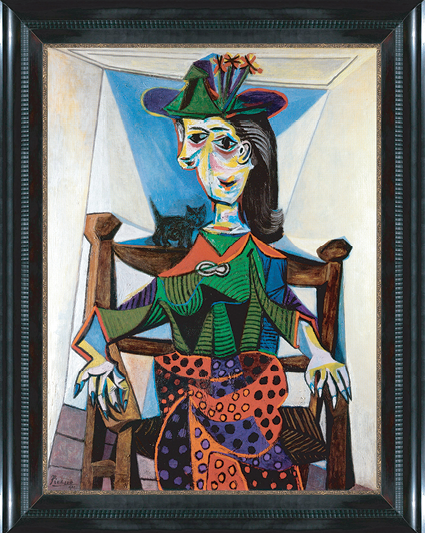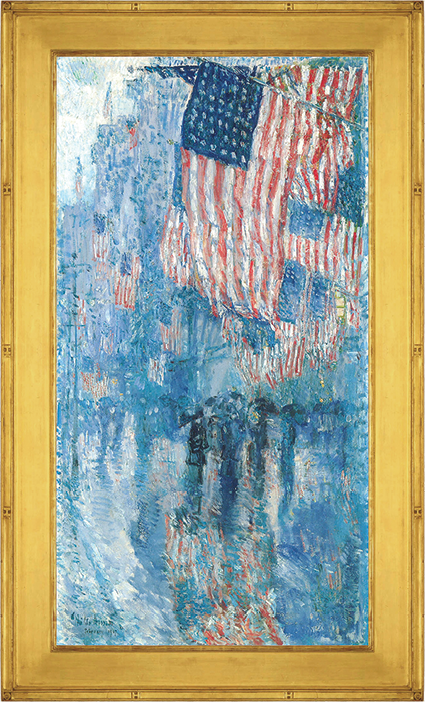- Home
- Media Kit
- MediaJet
- Current Issue
- Past Issues
- Ad Specs-Submission
- Ad Print Settings
- Reprints (PDF)
- Photo Specifications (PDF)
- Contact Us
![]()
ONLINE
![]()
ONLINE

Elevating Paintings
Editors’ Note
Eli Wilner is a leading frame dealer, frame restorer, and collector, as well as an acknowledged and published authority on the art of framing. His publications include Antique American Frames: Identification and Price Guide, and The Gilded Edge. Wilner has framed over 10,000 paintings, including the spectacular frame for Washington Crossing the Delaware for The Metropolitan Museum of Art, and 28 paintings for the White House.
Company Brief
Eli Wilner & Company (eliwilner.com) is a Manhattan gallery located on New York City’s Upper East Side. For 40 years, Eli Wilner & Company has specialized in European and American period frames and frame restoration, boasting a vast inventory of over 3,500 frames spanning the 15th century through the present. Since 1983, Eli Wilner & Company has published over 100 articles about antique frames, and collaborated extensively with curators from The Metropolitan Museum of Art, The Smithsonian American Art Museum, and The Cleveland Museum of Art.

Pablo Picasso’s Dora Maar au Chat,
framed by Eli Wilner & Company for Sotheby’s
Will you discuss the history of Eli Wilner and how the company has evolved?
I was just six years old when I first became aware of something the art world commonly overlooked: the beauty and value of a picture frame. My great-uncle was a well-known art collector and he would put my childish pastels in antique frames and hang them alongside his Modiglianis and Chagalls. It took me years to realize I wasn’t a great master, but I learned very early on how a frame can transform the way we look at a picture.
In 1978, I graduated from CUNY Hunter with a master’s degree in fine arts. During this time, I was working at an art gallery as a painting restorer and framer. I started collecting antique frames when I realized art dealers were throwing them out. No one wanted to spend money on restoring them because it was less expensive to reframe paintings with reproductions.
After amassing about 300 examples, I quit my job as a painting restorer and framer and, with the $6,000 I had saved, I opened a business selling frames in my cramped $230 a month Upper East Side studio apartment. My friends, family, and colleagues in the art world all thought I was insane. I’d been making a splendid living, but I was daydreaming about antique frames all the time. I actually couldn’t sleep at night – I was consumed by this vision, so the fact that I had no resources or employees was the least of my worries.
Now I have both a gallery on the Upper East Side and a studio in Long Island City. Since I opened, I’ve worked to promote the study and appreciation of period frames as valuable historical objects as well as works of art in their own right.

Childe Hassam’s Avenue in the Rain, framed with a
replica of an original Hassam frame by Eli Wilner & Company,
in the collection of The White House
Eli Wilner is celebrating its 40th anniversary. What have been the keys to Eli Wilner’s ability to remain relevant over four decades?
Primarily the interest that curators and directors have shown in the rediscovery of the importance of the period frame to an artwork. In turn, collectors have been educated and have recognized how the correct frame can elevate the aesthetic appreciation of their paintings.
Will you provide an overview of Eli Wilner’s services?
We are now focusing on the creation of replica frames based on original antiques. Unlike conventional reproduction frames, our precise replica frames are made using old-world techniques of carving and gilding, and the unmatched skill of our own in-house staff members. Each frame is made one at a time, with great care and artistry, using our antique frames as the models.
We also offer frame restoration services, and at times we even grudgingly sell antique frames from our collection. We only sell antique frames in very special circumstances, as our primary use for them is to serve as a library for the creation of replica frames, and as a color and surface reference for our frame restoration division.
We take special care to accommodate demands beyond basic framing and installation services, such as expedited production, on-site cosmetic frame restoration, general collection reviews to assess the condition of frames, and unfitting and refitting of artwork to assist a photographer or conservator. Eli Wilner & Company is a longtime preferred provider to both AXA and Chubb because of our renowned practices that reduce risk factors to clients’ artwork, frames, and furniture on premises.
.png)
Washington Crossing the Delaware, with a recreation
of the lost original frame by Eli Wilner & Company,
in the collection of The Metropolitan Museum of Art
How do you define the Eli Wilner difference?
The frames sold and made by our firm are sought for their quality and the expertise that we provide. At our gallery in Manhattan, we have a staff knowledgeable in the history of art and frames. Using our extensive inventory of original period frames, the gallery can match paintings and frames as the original artist had intended.
Eli Wilner & Company is highly sought-after for its depth of knowledge regarding the history of frames and frame choices made by artists, whether it be an Old Master painting, a Hudson River landscape, or a Picasso. All frames crafted by Eli Wilner & Company are created one at a time with hours lavished upon every detail from the basic profile to the intricacies of ornament and design to the subtleties and nuances of the gilded surface.
Aside from the specifics of frame selection, we anticipate and meet every need arising from a particular project. Pickup and delivery, arranging for proper packing and crating and the safe transport of artwork are considered. Artwork in our care is carefully stored. We guide our clients in the proper choice of glazing materials whether it be UV-filtering, glare reduction or other concerns such as weight. Archival methods and materials are used in the handling and fitting of artwork and frames.
Is there an effective understanding of the value and importance that a frame makes for a painting?
The clearest indication of the importance of a frame in enhancing the value of a painting is the fact that major auction houses have purchased and borrowed hundreds of frames from Eli Wilner & Company to enhance the aesthetic appeal of the artwork in their sales. Several of the works that we have lent frames for include the following:
Will you highlight some of the memorable projects that you have had the opportunity to work on over the past forty years?
One of Eli Wilner & Company’s most notable framing accomplishments was when we were commissioned by The Metropolitan Museum of Art to recreate a monumental frame for Emanuel Leutze’s Washington Crossing the Delaware (1851), based on rediscovered documentary photographs by Mathew Brady. The original frame in the Brady photographs had been inexplicably lost. I speak of the frame as “a tour de force, absolutely the most creative and involved surround for a painting that I have ever seen.” Not only does the frame have exterior dimensions of approximately 14x23 feet, it also features a fully hand-carved and gilded 14-foot wide crest consisting of Revolutionary War symbols such as an eagle, flags, pikes, bayonets, a drum, and a munitions case. An undulating ribbon at the base of the crest reads, “First in war, first in peace, first in the hearts of his countrymen,” a line excerpted from Henry Lee’s eulogy for Washington in 1799.
The Wilner staff spent years doing in-depth research alongside the Met’s curators, and meticulously handcrafting the frame. The frame has a wide cove profile with acanthus-leaf and leaf-and-berry cast ornaments. In addition to the crest, hand-carved elements include the embellished shields at the corners and individual stars set inside the cove. Using over 12,500 sheets of gold, the entire frame surface was water-gilded in the traditional fashion. The frame was so massive that it had to be designed for on-site assembly and was carried up the Museum’s Grand Stairwell in sections. A six-minute interview by Morley Safer from CBS Sunday Morning, which was done with Carrie Barratt of the Metropolitan Museum, can be viewed at EliWilner.com.
When President Clinton decided to hang Childe Hassam’s Avenue in the Rain (1917) in the Oval Office, Eli Wilner replaced the painting’s inappropriate reproduction frame by creating a carved and gilded replica of an original frame designed by the artist, including the artist’s signature “H” monogram. The painting was also hung prominently in the Oval Office during the Obama and current Biden Administrations.
When Sotheby’s received the consignment of an exceptionally important and large Picasso portrait, Dora Maar au Chat (1941), Eli Wilner was asked to create a frame worthy of the painting. We created a shaped and gilded replica of a 17th century Dutch style period frame, with an ebonized finish and gilded ornament at the sight edge. The frame was sold along with the painting for over $95,000,000, one of the highest prices ever paid for a Picasso at auction.
What are your priorities for Eli Wilner as you look to the future?
We are excited about the interest we are seeing in framing contemporary artwork. There was a recent exhibition at the Isabella Stewart Gardner Museum that included works by the American realist painter Kehinde Wiley. Along with several other contemporary painters, Wiley uses ornate carved and gilded frames on his paintings, harkening back to the way frames have been used through the centuries to elevate paintings. We look forward to continuing that tradition with the next generation of artists who are utilizing antique frames in their work.![]()